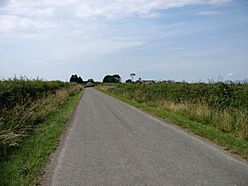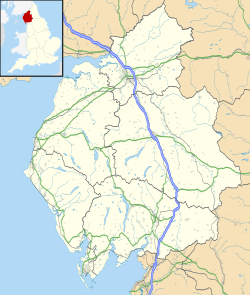Milefortlet 3 facts for kids
Quick facts for kids Milefortlet 3 |
|
|---|---|

Looking towards Pasture House Farm, and the approximate site of Milefortlet 3
|
|
| Type | Milecastle |
| Place in the Roman world | |
| Province | Britannia |
| Location | |
| Coordinates | 54°55′57″N 3°16′18″W / 54.932558°N 3.271664°W |
| County | Cumbria |
| Country | England |
Milefortlet 3 (Pasture House) was a small fort built by the Romans. It was part of a long line of defences along the Cumbrian coast in what is now England. These defences included many small forts called milefortlets, along with stone watchtowers. They stretched out from the western end of Hadrian's Wall. All these structures were built around the same time to protect the Roman Empire. Today, you can't see much of Milefortlet 3 on the ground. However, experts have found its location using special aerial photographs.
Finding Milefortlet 3
Milefortlet 3 is located in a field near Pasture House Farm. This area is part of the civil parish of Bowness. In 1945, people found signs of old turf walls just beyond a stream near the farm. This helped them figure out where the fort was. While there isn't much to see from the ground, most of the fort's shape was visible as a "soilmark" in aerial photographs taken in 1946. A soilmark is a change in soil color or plant growth that shows where old structures used to be.
Watchtowers Along the Coast
Each milefortlet had two smaller watchtowers connected to it. These towers were built in a similar way to the turrets found along Hadrian's Wall. They were placed about one-third and two-thirds of a Roman mile to the west of each milefortlet. Soldiers from the nearby milefortlet would have guarded these towers. The towers linked to Milefortlet 3 are known as Tower 3A and Tower 3B.
The exact spot of Tower 3A is not certain. There used to be a small hill in a field about 400 metres west of Pasture House. This might have been its location. The site of Tower 3B is in another field and is now a protected historical site called a Scheduled Ancient Monument. In 1880, archaeologists dug at Tower 3B. They found a floor made of flat stones. On this floor, they discovered pieces of pottery, a handle from a large storage jar called an amphora, some human bones, and many mussel shells.


